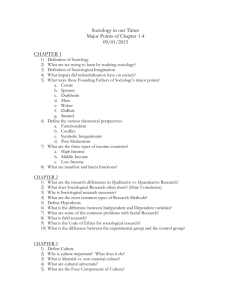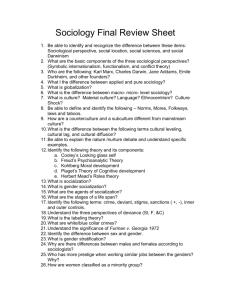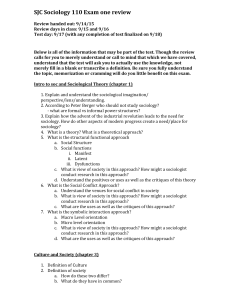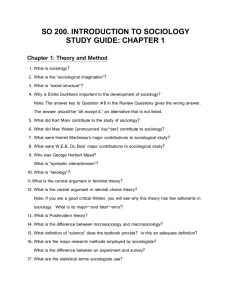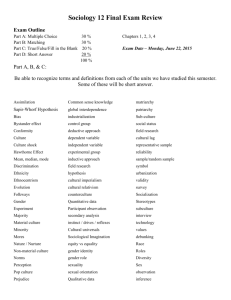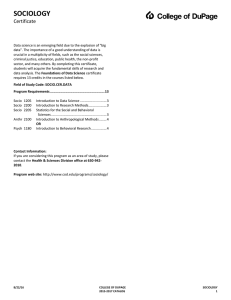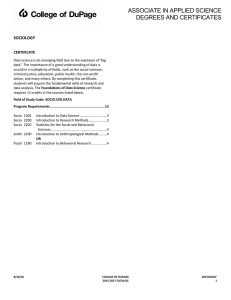Socio 125 Sociology of the Family
advertisement
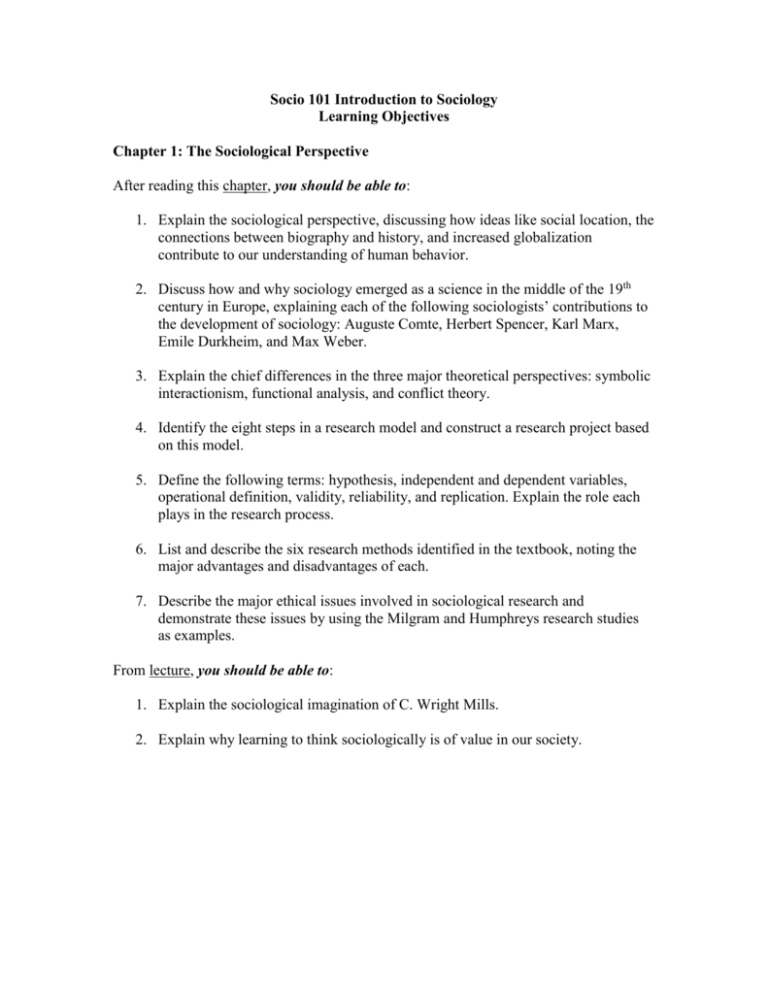
Socio 101 Introduction to Sociology Learning Objectives Chapter 1: The Sociological Perspective After reading this chapter, you should be able to: 1. Explain the sociological perspective, discussing how ideas like social location, the connections between biography and history, and increased globalization contribute to our understanding of human behavior. 2. Discuss how and why sociology emerged as a science in the middle of the 19th century in Europe, explaining each of the following sociologists’ contributions to the development of sociology: Auguste Comte, Herbert Spencer, Karl Marx, Emile Durkheim, and Max Weber. 3. Explain the chief differences in the three major theoretical perspectives: symbolic interactionism, functional analysis, and conflict theory. 4. Identify the eight steps in a research model and construct a research project based on this model. 5. Define the following terms: hypothesis, independent and dependent variables, operational definition, validity, reliability, and replication. Explain the role each plays in the research process. 6. List and describe the six research methods identified in the textbook, noting the major advantages and disadvantages of each. 7. Describe the major ethical issues involved in sociological research and demonstrate these issues by using the Milgram and Humphreys research studies as examples. From lecture, you should be able to: 1. Explain the sociological imagination of C. Wright Mills. 2. Explain why learning to think sociologically is of value in our society. Socio 101 Introduction to Sociology Learning Objectives Chapter 2: Culture After reading this chapter, you should be able to: 1. Define culture and explain its material and nonmaterial components. 2. Explain why ethnocentrism is a natural tendency. 3. State what cultural relativism is and discuss why it is a worthwhile goal even though it presents challenges to us. 4. Identify the different ways in which language makes human life possible. 5. Define the following terms: values, norms, sanctions, folkways, mores and taboos. 6. Compare and contrast dominant culture, subcultures, and countercultures. 7. Explain the difference between “ideal” and “real” culture, providing examples. 8. Define cultural lag and explain its role in relationship to cultural change. 9. Discuss the link between technology, cultural diffusion and cultural leveling. Socio 101 Introduction to Sociology Learning Objectives Chapter 3: Socialization After reading this chapter, you should be able to: 1. Define socialization and explain its goals. 2. Discuss how socialization accounts for both conformity and difference in human behavior. 3. Discuss the role of nature (heredity) and nurture (environment) in social development. 4. Explain the impact of extreme isolation on the socialization process and the effect these cases of extreme isolation taught us about the nature/nurture debate. 5. Define the self and explain how the socialization process contributes to the development of the self. 6. Explain how the looking glass self is created. 7. Explain Mead’s theory of how the self develops. 8. Identify the agents of socialization and give examples of each and their potential influence. 9. Explain how adult socialization is different from early childhood socialization. 10. (From Chapter 4) Describe the concepts of role, status, master status, role conflict and role strain. Socio 101 Introduction to Sociology Learning Objectives Chapter 4: Social Structure and Social Interaction After reading this chapter, you should be able to: 1. Differentiate between macrosociology and microsociology and indicate which one is most likely to be used by funcionalists, by conflict theorists, or by symbolic interactionists. 2. Discuss social structure and explain how one’s location in this structure affects that person’s perceptions, attitudes, and behaviors. 3. Define and differentiate between ascribed and achieved status, providing an example of each. 4. Recognize the various statuses, roles and master statuses. 5. Outline the key components of the dramaturgical view of everyday life and discuss how we manage our impression using sign-vehicles, teamwork, and facesaving behavior. 6. Discuss what background assumptions are, according to ethnomethodology. 7. Explain what the “social construction of reality” means and how this is related to the Thomas theorem. Socio 101 Introduction to Sociology Learning Objectives Chapter 5: Social Groups and Formal Organizations After reading this chapter, you should be able to: 1. Define “group” and differentiate between primary and secondary groups. 2. Explain the differences between in-group and out-group and the implications each holds for human behavior. 3. Relate in-group/out-group behavior to ethnocentrism. 4. Define the five essential characteristics of bureaucracies identified by Weber. 5. Explain what is meant by the phrase “the rationalization of society.” 6. Distinguish between dyads and triad and describe how group size affects group dynamics. 7. Explain the difference between the two types of group leaders and the three styles of leadership. 8. Discuss the characteristics of people who become leaders and how leadership type is influenced by the situation. 9. Discuss the findings of the Asch and Milgram experiments and the ethical questions raised by these experiments. 10. Define groupthink, discuss its implications and describe ways to prevent it.

